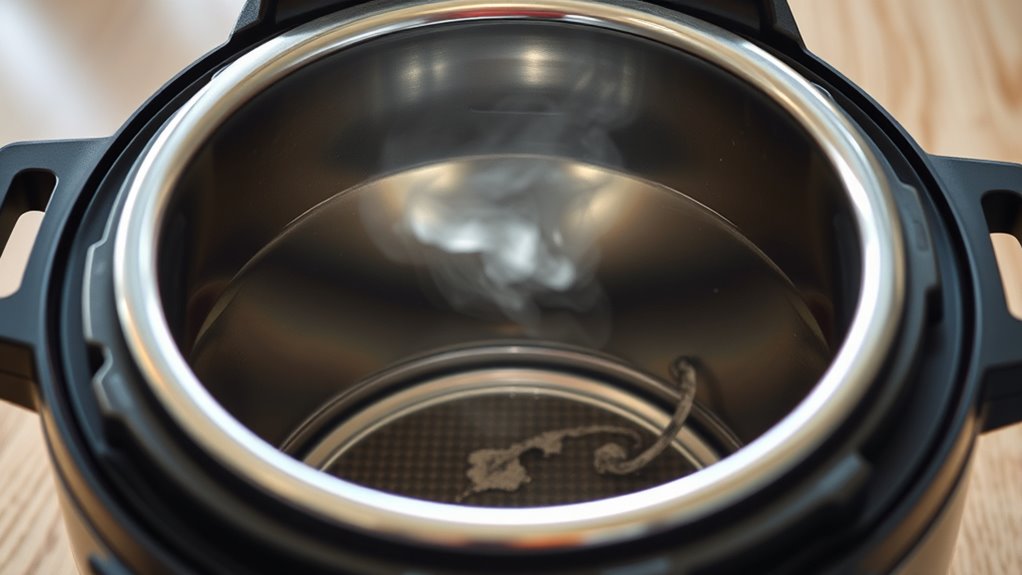Your Instant Pot can hide silent dangers like burn notices or pressure leaks if you don’t maintain it properly. Food residue, improper sealing, or low liquid levels can cause malfunctions or safety issues. Regularly check and clean the sealing ring, ensure ample liquid, and verify that the lid is sealed tightly. These small details prevent silent hazards. Want to discover more ways to keep your Instant Pot safe and trouble-free? Keep going for essential tips.
Key Takeaways
- Improper sealing and damaged gasket can cause steam leaks, leading to false burn warnings and safety hazards.
- Insufficient liquid or food residue can trigger burn notices and hinder proper pressure buildup.
- Food sticking to the inner pot or lid debris interfere with sensors, risking malfunction and unsafe operation.
- Faulty sensors or control boards may cause repeated burn alerts despite correct usage.
- Regular cleaning, proper sealing, and correct liquid levels are essential to prevent silent dangers and ensure safe Instant Pot use.
Common Causes of Burn Notices in Instant Pot
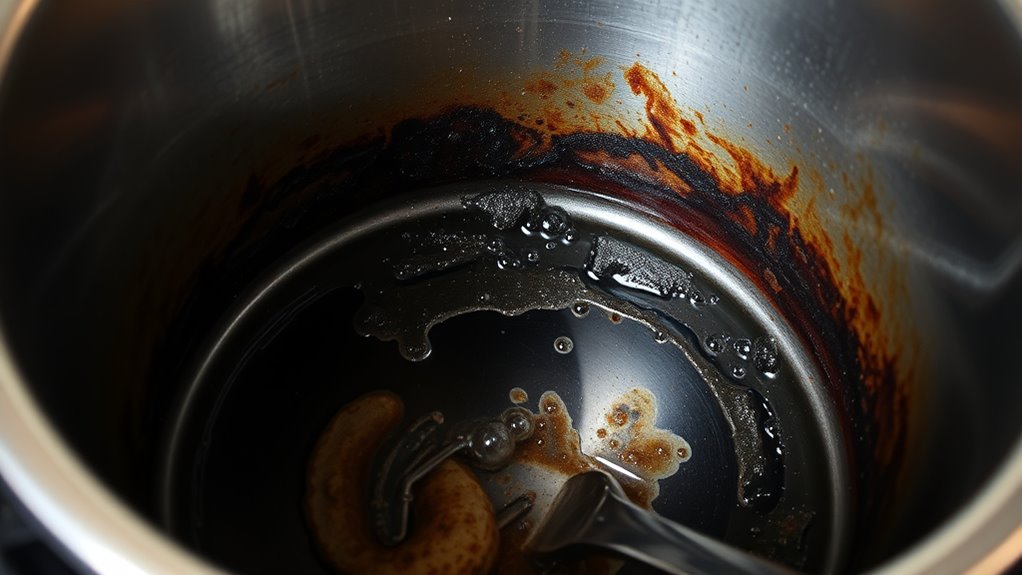
Burn notices often happen when food sticks to the bottom of your Instant Pot’s inner pot, especially during sautéing or cooking thick sauces. When you don’t add enough liquid—less than 1/4 cup—it can prevent proper pressure buildup, increasing the risk of burning. Thick recipes like chili or stew need extra water or broth to avoid scorching. Food debris or spills inside the pot can also interfere with pressure regulation, triggering the warning. Additionally, if the lid’s sealing isn’t tight, steam escapes, causing the device to think food is burning even if it isn’t. To reduce the risk of burn notices, it’s important to monitor pressure regulation and ensure the appliance’s components are functioning properly. These issues all contribute to a burn notice, so paying attention to liquid levels, sealing, and cleaning the inner pot helps prevent this common problem during your cooking. Proper inner pot maintenance and ensuring all parts are correctly assembled can also help prevent false alarms. Being aware of robotics integration in kitchen appliances can also aid in troubleshooting and maintaining your Instant Pot.
Why Proper Sealing Is Essential for Safe Cooking
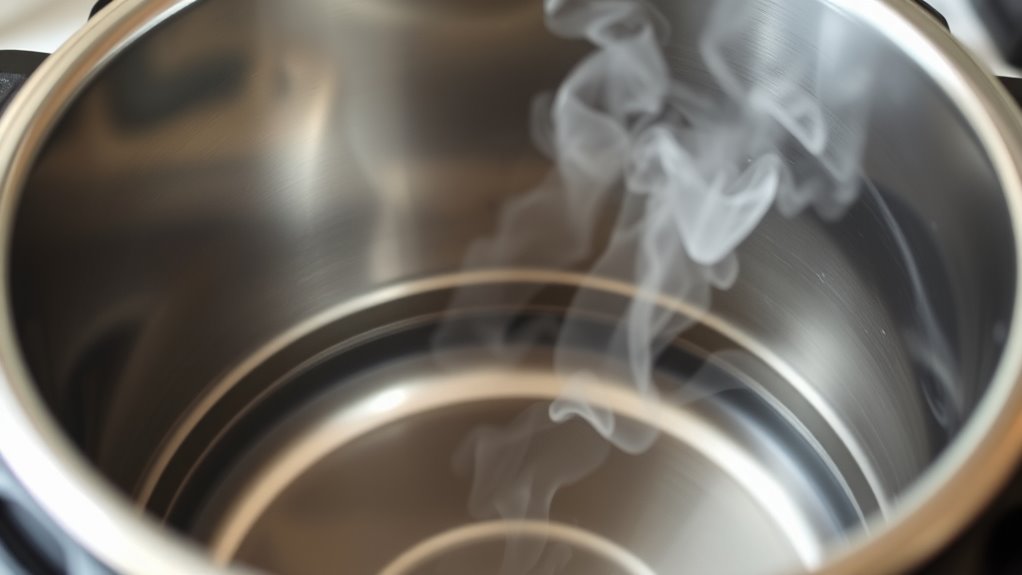
Ensuring your Instant Pot is properly sealed is essential because it allows steam to build up pressure safely and efficiently. A loose or improperly seated sealing ring can cause steam to escape, which disrupts the pressure levels needed for proper cooking. This not only affects cooking results but also creates safety hazards, such as pressure leaks. If the lid isn’t securely locked or the sealing ring isn’t correctly in place, you risk pressure malfunctions that can lead to dangerous situations. An intact, snug sealing ring maintains consistent internal pressure, preventing accidental steam releases that could cause burns or damage your kitchen. Regularly inspecting and replacing the sealing ring guarantees your Instant Pot functions safely, reducing the risk of pressure-related accidents and keeping you protected during every use. Proper sealing is a crucial aspect of safe pressure cooking. Additionally, proper sealing helps maintain the appliance’s performance and longevity, ensuring it operates efficiently over time. Proper maintenance of the sealing mechanism can further enhance safety and efficiency, especially since air leakage can compromise the device’s overall function. Regular cleaning of the sealing parts also helps prevent buildup of debris, which can compromise the seal and lead to leaks.
The Role of Liquid Levels in Preventing Burn Errors
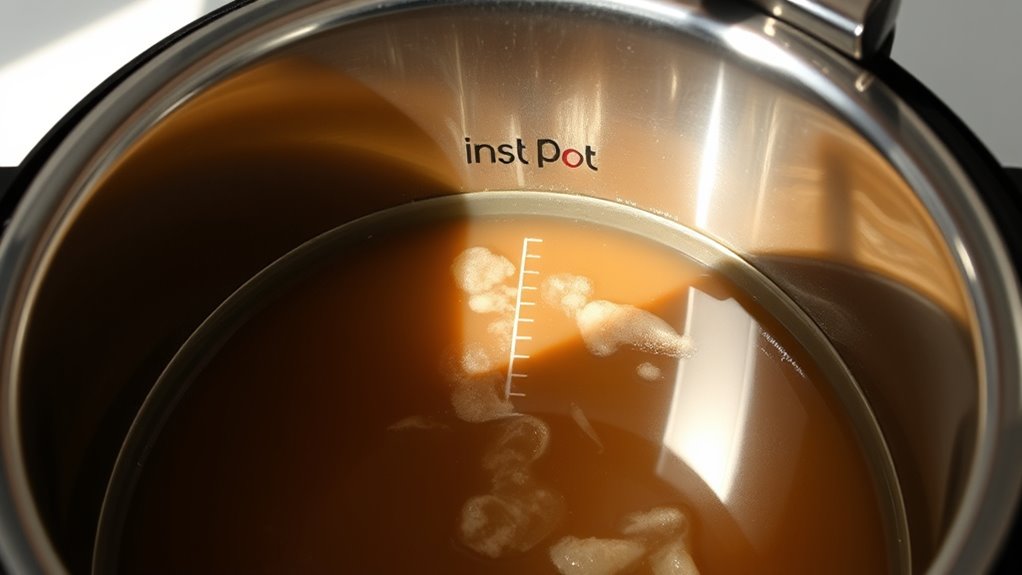
Maintaining the correct liquid level inside your Instant Pot is key to preventing burn errors during pressure cooking. You should aim for at least 1 to 1.5 cups of liquid to generate enough steam for proper pressure buildup. Recipes with thick sauces or stews often need extra water or broth to keep the liquid level sufficient throughout cooking. If the liquid drops below 1/4 cup, food can stick and burn onto the bottom, triggering the burn warning. Always check that you meet the minimum liquid requirements specified by the manufacturer for your model. To reduce burn errors, consider adding extra liquid or water to account for evaporation and absorption during cooking. Proper liquid levels ensure smooth pressure buildup and prevent food from burning. Additionally, understanding liquid level requirements can help you troubleshoot and prevent common issues with your Instant Pot. Ensuring consistent liquid distribution within the pot can also help prevent hot spots that lead to burning. Maintaining adequate liquid circulation ensures even heat distribution and minimizes the risk of burning. Being attentive to liquid evaporation rates during cooking can further help in maintaining the ideal liquid level.
How Food Residue Can Trigger Malfunctions
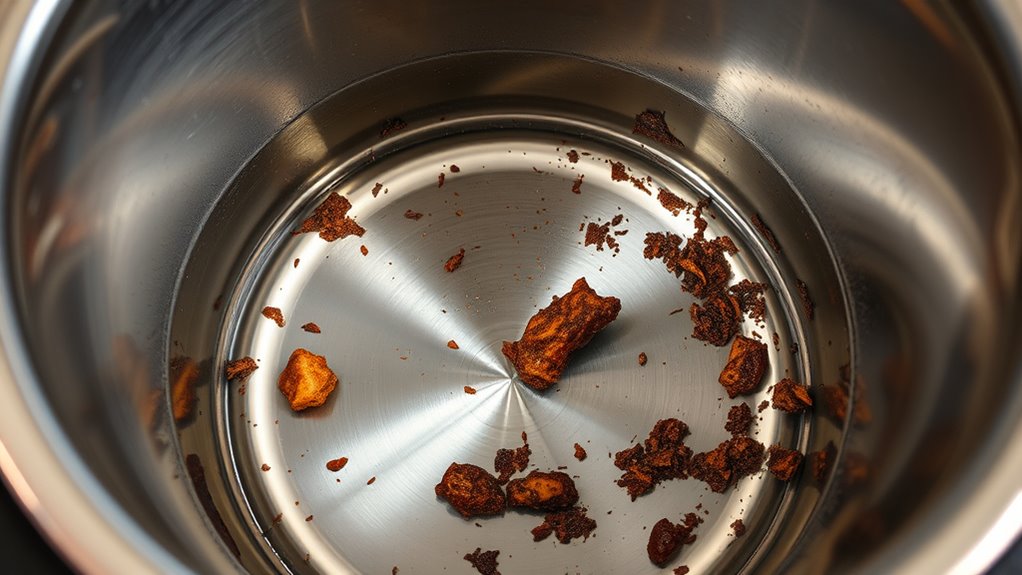
Food residue left on the bottom or sides of your Instant Pot’s inner pot can easily trigger malfunctions by causing the device to detect a burn condition. Small particles or dried food buildup inside the chamber may interfere with pressure sensors, leading to false burn alerts during cooking. Residue from thick sauces or browned foods can create hotspots, increasing the risk of burning and further malfunctions. If you don’t clean the inner pot thoroughly after each use, residue accumulates and can cause repeated burn warnings in future cycles. Food debris trapped in the sealing ring or lid components can also disrupt sensor readings, raising safety concerns. Regular, proper cleaning guarantees that residue doesn’t interfere with your Instant Pot’s performance or safety. Additionally, using proper cleaning techniques can help maintain the device’s optimal operation and extend its lifespan. Implementing preventative maintenance practices ensures the device remains reliable and safe over time. Moreover, neglecting these cleaning routines may lead to long-term damage, which can compromise the appliance’s durability and performance. Recognizing the importance of cleaning not only helps avoid malfunctions but also supports the overall safety and efficiency of your Instant Pot.
Troubleshooting Tips for Sealing and Steam Leaks
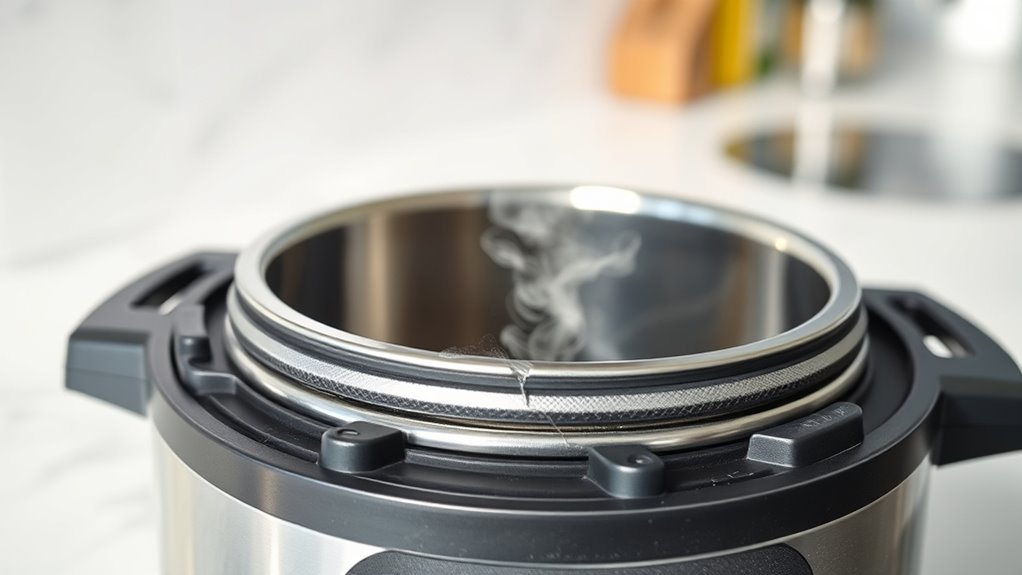
To keep your Instant Pot safe and functioning properly, you need to verify the lid seals tightly and is free of debris. Check that the pressure release valve and steam release knob are set correctly before cooking, and inspect the lid for cracks or damage. Regularly clean and maintain the sealing ring and lid components to prevent leaks and ensure a proper seal. Using an eye patch can help reduce puffiness and improve the appearance of your eyes after long cooking sessions or late nights in the kitchen. Additionally, understanding performance tuning principles can help you troubleshoot and optimize your appliance settings for better safety and efficiency. Ensuring that all safety features are properly engaged can further prevent accidents and leaks during operation.
Ensuring Proper Lid Sealing
Ensuring your Instant Pot is properly sealed is essential for safe and effective cooking. First, confirm the sealing ring is seated correctly and free of debris. Make sure the lid clicks securely into place, and the steam release knob is set to sealing. Check for gaps or misalignments around the lid and ring that could cause steam leaks. Regularly inspect the sealing ring for cracks or wear, replacing it when necessary. Test the lid’s locking mechanism and pressure release components periodically to prevent accidental leaks. Use this quick reference:
| Step | Action |
|---|---|
| Seal Ring | Properly seated and clean |
| Lid Locking | Clicks securely into place |
| Pressure Components | Functioning correctly and undamaged |
Proper sealing keeps your pressure consistent and safe.
Checking for Steam Leaks
Checking for steam leaks is a crucial step to guarantee your Instant Pot operates safely and efficiently. Start by ensuring the silicone sealing ring is properly seated and free of debris, which helps prevent steam from escaping during pressure cooking. Next, verify the steam release knob is set to “Sealing” and not “Venting” before starting your cycle. Inspect the lid for cracks or damage that could compromise the seal, and check for gaps or misalignment in the lid locking mechanism, as these can cause leaks. Regularly clean the lid and sealing ring to maintain an effective seal. If you notice steam escaping during operation, recheck these components carefully, as even small misalignments or debris can lead to unnoticed leaks that pose safety risks.
Maintaining Sealing Components
Maintaining the sealing components of your Instant Pot is essential for safe and efficient operation. Regular checks ensure the seal works properly, preventing steam leaks and potential hazards. Before each use, verify the sealing ring is properly seated and free of debris. Inspect it for cracks, wear, or stiffness, and replace it if needed. Always confirm the lid is securely locked, and the pressure valve is set to sealing. After cooking, clean the sealing ring and lid gasket thoroughly to remove food residue that could compromise the seal. Check for damage or deformation, and replace faulty parts promptly to avoid steam escapes and burn notices.
- Verify the sealing ring is properly seated and debris-free
- Regularly inspect for cracks, wear, or stiffness
- Confirm the lid is securely locked and pressure valve set to sealing
- Clean sealing components after each use
Recognizing Signs of Hardware or Model Issues
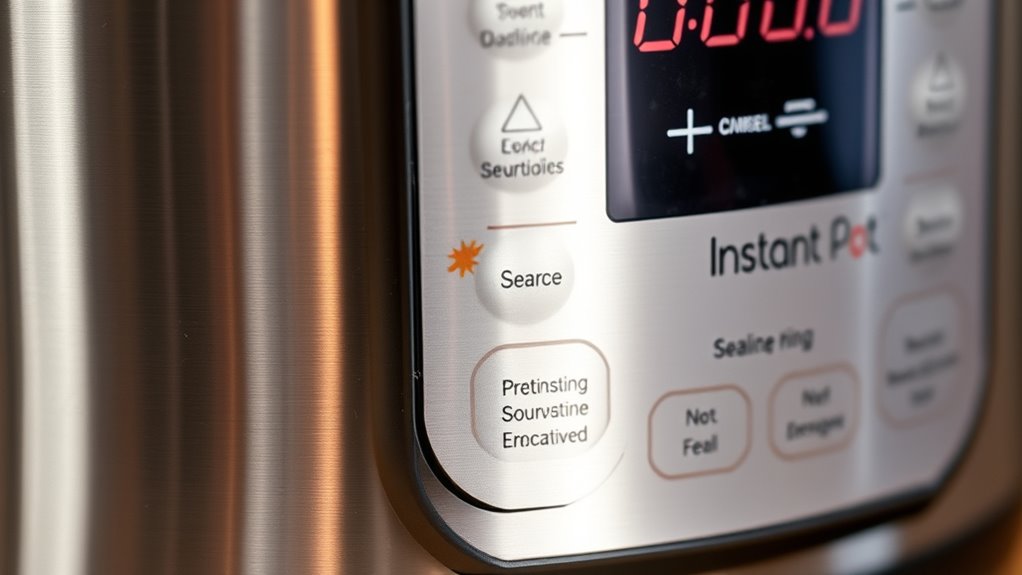
If your Instant Pot keeps showing unusual burn notices or struggles with pressure, it could be a sign of hardware issues. Leaking, noisy lids, or persistent error messages are also red flags that something’s wrong with the model. Regularly inspecting and maintaining your appliance helps catch these problems early before they turn into bigger risks.
Unusual Burn Notices
Unusual burn notices on your Instant Pot can be a sign of hardware or model issues rather than just cooking mistakes. If you see these warnings frequently despite proper liquid levels and sealing, it could indicate a faulty temperature sensor or heating element. Inconsistent or premature burn alerts might also point to a damaged control board that can’t monitor cooking conditions properly. Older or lower-quality models often have overly sensitive burn detection systems, triggering alerts unnecessarily. Persistent warnings despite troubleshooting may mean internal component malfunctions or manufacturing defects, requiring professional inspection. Recognizing these patterns can help you identify underlying hardware problems early, preventing further damage and ensuring your device’s safety.
- Repeated burn notices with proper liquid levels
- Premature alerts on older or lower-quality models
- Inconsistent warnings indicating control board issues
- Persistent warnings despite troubleshooting
Persistent Pressure Problems
Have you noticed your Instant Pot struggling to reach or hold the desired pressure? This could signal a hardware issue like a faulty pressure sensor or a worn sealing component. If you keep getting burn notices despite proper troubleshooting, it might point to problems with the pressure release valve or lid gasket. Inconsistent pressure buildup or sudden drops during cooking are signs of a defective pressure control mechanism or a damaged sealing ring. Some models even have design flaws that cause ongoing pressure regulation issues, despite correct use and maintenance. Additionally, abnormal hissing sounds or the inability to build pressure can hint at hidden hardware or model-specific problems affecting performance. Recognizing these signs early can help prevent more serious malfunctions.
Leaking or Noisy Lid
A leaking or noisy lid is a common sign that your Instant Pot may be experiencing hardware or model issues. You might notice steam escaping from the sides, a persistent hissing, or a loud whistling sound during pressure cooking. These symptoms often point to improper sealing, worn gaskets, or damage to the lid components. A loose or misaligned sealing ring can cause leaks and strange noises, compromising pressure build-up. Recurring leaks or unusual sounds may also signal a faulty lid latch or a cracked lid needing inspection or replacement. Regularly check for cracks, warping, or debris on the lid and gasket to prevent noisy operation and ensure proper sealing. Addressing these signs early can protect your appliance and keep your cooking safe.
Preventative Practices to Keep Your Instant Pot Safe

To keep your Instant Pot operating safely, it’s essential to follow preventative practices that minimize risks. Regularly inspect and clean the sealing ring and lid components to ensure they seal properly and prevent leaks, which could trigger burn notices. Always add enough liquid—at least 1/4 to 1 cup—to prevent food from sticking and burning during cooking. Before starting, scrape the bottom of the inner pot thoroughly to remove food residues that could cause burn warnings. Use a wooden spoon to loosen any stuck food on the bottom before sealing the lid, reducing the chance of burning and alert triggers. Finally, double-check that the steam release knob is set to sealing and that the lid is securely closed. These steps help keep your Instant Pot safe and functioning efficiently.
Frequently Asked Questions
What Happens if You Don’t Vent an Instant Pot?
If you don’t vent your Instant Pot, you risk dangerous pressure buildup. The steam can’t escape, which can cause the lid to become difficult to open or even force it off unexpectedly. Excess pressure may lead to malfunctions, damage the appliance, or cause steam leaks. To stay safe and keep your Instant Pot working properly, always make certain you vent it correctly after cooking, releasing pressure safely before opening.
Is It Unhealthy to Cook in an Instant Pot?
Cooking in an Instant Pot isn’t unhealthy if you follow the instructions. You’ll retain more nutrients than traditional methods, and modern coatings are food-safe. Just avoid overcooking or burning food, which can produce harmful compounds. Make certain you add enough liquid and seal the lid properly. When used correctly, your Instant Pot is a safe, convenient way to cook healthy meals quickly without significant health risks.
Which Instant Pot Is on Recall?
You’re wondering which Instant Pot models are on recall. You should check your device’s serial number and model details against the official recall list on the Instant Pot website or CPSC notices. Several models with specific batch numbers have been recalled due to overheating and fire risks. If yours matches, stop using it immediately and follow the manufacturer’s instructions for free repairs, replacements, or refunds to stay safe.
What Do You Do if You Get the Inside of Your Instant Pot Wet?
If the inside of your Instant Pot gets wet, first unplug it to guarantee safety. Wipe down all interior surfaces with a dry, lint-free cloth to remove excess moisture. Avoid submerging any parts in water. Make sure the inner pot, lid, sealing ring, and electronic components are completely dry before reassembling and using it again. Regularly check for moisture buildup to prevent potential malfunctions.
Conclusion
To keep your Instant Pot safe, stay vigilant about sealing, liquid levels, and residue. Think of your pressure cooker as a trusted friend—neglect it, and it might betray you with a silent danger. Regularly check for leaks and malfunctions, and don’t ignore warning signs. By practicing these habits, you’re not just preventing errors; you’re ensuring every meal is safe and delicious. After all, a well-maintained Instant Pot is the key to stress-free, flavorful cooking.
